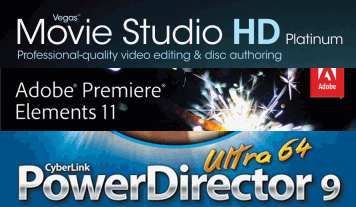Software for Video Editing
What software should I use for editing digital home videos, and for making DVDs from them?
Answer:
It depends.
There are four stages in getting video recorded and from there to a finished DVD.
Stage 1: Recording
For those who have newer and higher-quality cameras/ camcorders, the main pitfall here may be recording your video in quality that’s “too high!”
If you have a newer camcorder and a bit older computer, you may find that on higher qualities you overwhelm your computer’s ability to process the video.
Of course, if you have an older, lower-quality camera and a really fast new computer, this may not be an issue.
But before taking tons of video that you want to edit, you’ll want to experiment to see how well your computer is going to handle the video editing task.
Stage 2: Getting the Video from Your Camera/ Camcorder to Your Computer
To transfer the video, you’ll need to either use software that came with your camera, or other (third-party) software.
And you’ll need to either connect your video recording device to the computer using a USB cable, or you’ll need to physically remove a data card from your video recording device and insert it into a card reader.
For general uploading and photo/ video management on your computer, I recommend the free Picasa software, provided by Google. You can get this at picasa.google.com. Note however that Picasa might not support all formats of video. In that event, you’ll need to use the appropriate software that came with your camera or camcorder.
Stages 3 and 4: Editing the Video and Producing Your DVDs
The first rule of editing video is that you need a computer powerful enough to do the job. Generally, if your computer is an older Windows XP system, you may find that it’s not really up to the task. I recommend having a newer Windows 7 machine with at least 4 gigabytes of memory. Even with newer machines, processing video takes time.
There are 3 major contenders for video editing and DVD production: Sony’s Vegas line of video editing products, Adobe’s Premiere products, and Cyberlink’s PowerDirector products.
First of all, we should state that there’s not really any such thing as perfect video editing software. Each of the following products has people who haven’t enjoyed their experience with it. The most common complaint is of programs crashing frequently. And this problem can occur no matter which software package you use.
That said, for most of us, any of these products are likely to do the basic job. But some may work better than others.
Which Program?
Overall, I personally would tend to go with Sony’s Vegas Movie Studio HD Platinum 10 Production Suite. However, your choice might vary. Here’s the rundown.
Sony: Products vary from their most basic video editing program (around $50) on up to a professional suite.
In the middle are their Vegas Movie Studio HD Platinum 10 software (around $100), and their Vegas Movie Studio HD Platinum 10 Production Suite. The latter has a list price of $125, but Springfield Computer Guy customers can currently get it for $105. To me, the extra few bucks is well worth the extras you get, including lots of extra transition effects, and music that you can add to your videos.
If you want to create DVDs, I’d stay away from Sony’s most basic product.
The main down side of Vegas Movie Studio is that it may not be as easy to use as, say, Adobe Premiere Elements. However, this is a powerful program, one which has really satisfied many users with what it can do.
Adobe: If user friendliness is your top priority, then you may want to go with Adobe Premiere Elements (around $100). They also have a bundled edition with Photoshop Elements, but if you only want video editing, then Premiere Elements would be what you want.
Cyberlink: The place where I would choose Cyberlink’s PowerDirector software would be if I had a newer, 64-bit computer with a 64-bit operating system, AND I wanted a program that would work really fast.
In that case, I would probably choose Cyberlink PowerDirector Ultra64. Cyberlink promises much faster video processing time, and reports from people who’ve actually used the program (on a 64-bit machine with a 64-bit operating system) confirm that they with the right equipment on your part, they deliver.
The cost of around $100 is similar to that of its competitors.
So those are the choices. Whatever program you choose, video editing is a more challenging task than most of the other things people do on their computers. It takes some learning. It takes quite a bit of computer resources. The more powerful computer you have, the better. And if you do very much of it, it also takes a lot of hard disk space.
All of that said, editing your own videos, and producing your own DVDs from them, is definitely doable. Get the right camera or camcorder, get some decent software, and go for it!

